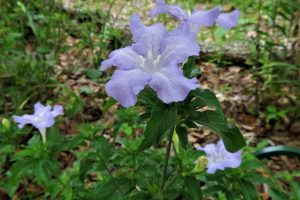 You may be seeing the Carolina Wild Petunia (Ruellia caroliniensis) popping up in your lawns in early spring. It is a pretty little plant native to Florida and endemic to the southeastern U.S.
You may be seeing the Carolina Wild Petunia (Ruellia caroliniensis) popping up in your lawns in early spring. It is a pretty little plant native to Florida and endemic to the southeastern U.S.
It is a herbaceous, long-lived perennial and one of the first wildflowers to bloom in the spring. It has a strong woody root system that allows it to survive winter freezes and quickly come back in the spring. It also holds up very well for transplanting.
Carolina Wild Petunia is a must-have plant for pollinator gardens. It is a source of nectar and pollen for bees, butterflies, wasps and hummingbirds. It is also the host plant for the larva of the Common Buckeye and White Peacock butterflies.
It self-seeds readily. Seeds can also be harvested once the flower withers and the seed capsule turns brown. Seeds should be cold stratified to insure germination. It can also be propagated from cuttings and plant divisions after a few years.
If you find it growing in your lawn, consider transplanting it to a garden where you can enjoy its beauty and it can benefit the pollinators. It can handle full sun to part shade. It likes sandy, well-drained alkaline soil. It has good drought tolerance. It will grow to a height of 12 to 24 inches.
Although plants in the Ruellia genus may be called “petunias” they are not even closely related to true petunias, which are members of the Petunia genus. It is only the similarity in appearance that give them their common name.
Please note that many nurseries sell the non-native Mexican petunia (Ruellia simplex) which should be avoided because it spreads via underground rhizomes, does not respond well to herbicides, and has been classified a Category I invasive species that is displacing native species. For more information from the University of Florida on Mexican Petunias – please click the highlighted words.
This post is written by MGV, Walter Bryant, who assures us there are often many alternative for invasive plants. IN the case of Mexican Petunias, consider –
Eranthemum pulchellum, Blue sage
Plectranthus spp., Plectranthus
Plumbago auriculata, Plumbago
Ruellia simplex (formerly brittoniana), ‘Purple Showers’y, ‘Purple Showers’ Mexican petunia (sterile, non-invasive by seed dispersal)
Ruellia simplex R10-105-Q54y , Mayan Pink Mexican petunia (sterile, non-invasive by seed dispersal)
Ruellia simplex ‘R10-102’y , Mayan Purple Mexican petunia (sterile, non-invasive by seed dispersal)
Ruellia simplex ‘R10-108’y, Mayan White Mexican petunia (sterile, non-invasive by seed dispersal)
Ruellia simplex ‘R12-2-1’y , Mayan Compact Purple Mexican petunia (sterile, non-invasive by seed dispersal)
Salvia farinacea, Mealycup sage
Salvia greggii, Autumn sage
Salvia leucantha, Mexican sage
Vernonia gigantea, Giant ironweed
A complete list is available – https://edis.ifas.ufl.edu/pdf/EP/EP46700.pdf
 4
4
